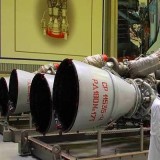Focus: US-based GA-ASI Develops Gambit New Unmanned Aircraft to Support F-35 & Next-Gen Fighter Operations
{loadposition bannertop}
{loadposition sidebarpub}
The future of air power lies in the seamless integration of manned and unmanned systems, where autonomous unmanned aircraft serve as force multipliers, complementing and augmenting the capabilities of advanced human-crewed fighters. At the forefront of this transformation is General Atomics Aeronautical Systems, Inc. (GA-ASI) with its Gambit advanced unmanned aircraft series, designed to work alongside the most advanced manned aircraft, such as the F-35 Lightning II and the Next-Generation Air Dominance (NGAD) systems.Follow Army Recognition on Google News at this link
American Company GA-ASI develops the Gambit Autonomous unmanned aircraft to enhance F-35 and Next-Gen fighter operations through collaborative missions. (Picture source: GA-ASI)
The central goal of the Gambit family of unmanned aircraft is to pair large numbers of autonomous systems with potent human-piloted fighters, ensuring that future air forces can dominate the battlespace with a combination of magazine depth, sustained situational awareness, and adaptability—all while minimizing risks to human pilots.
In the high-stakes, dynamic environment of modern warfare, a pilot in an advanced fighter like the F-35 is faced with increasingly complex missions that demand more than just raw firepower and agility. These pilots need the ability to operate in a more collaborative, multi-dimensional combat environment—where autonomous unmanned aircraft serve as teammates, carrying out critical tasks that increase the overall operational effectiveness of the air force. Here’s how the Gambit series helps fulfill these roles:
Magazine Depth and Force Augmentation: One of the most challenging aspects of modern air combat is ensuring that a combat force can sustain offensive and defensive operations. The concept of magazine depth refers to the ability to maintain a continuous supply of munitions and operational capability during prolonged engagements. The Gambit platforms play a pivotal role here by providing unmanned magazine depth—aircraft that can carry additional weapons, sensors, and combat payloads without placing a strain on human pilots. These unmanned systems can provide critical support to human-crewed fighters, including arming, resupply, and additional combat options that extend the reach and lethality of the entire air package.
Situational Awareness and Surveillance: The modern battlefield is more congested and contested than ever before. Pilots in F-35s or NGAD systems require constant, real-time intelligence to make critical decisions. The Gambit platforms, particularly models like the Gambit 1, are built for persistent surveillance. By flying in coordinated swarms, these autonomous aircraft can surveil vast stretches of airspace, detect threats, and relay intelligence back to human pilots and other systems in the air and on the ground. The Gambit’s ability to sense, process, and share data autonomously allows human operators to make quicker, more informed decisions while staying one step ahead of adversaries.
GA-ASI’s Gambit Series: Four advanced unmanned aircraft variants—Gambit 1 for surveillance, Gambit 2 for combat, Gambit 3 for training, and Gambit 4 for stealth and endurance—designed to collaborate with F-35 and Next-Gen fighters. (Picture source GA-ASI)
Evasion and Detection Mitigation: One of the most potent advantages of unmanned systems like the Gambit is their ability to evade detection and operate in high-threat environments without risking human lives. Gambit aircraft, such as the Gambit 4, are designed with advanced low-observable technologies, ensuring that they can operate in contested airspaces, gathering critical information or striking high-value targets, while remaining undetected. By flying in close formation with manned aircraft or operating autonomously, these drones can reduce human pilots’ exposure to enemy radar or missile systems, essentially acting as decoys or providing countermeasures.
Autonomous Action and Collaboration: The Gambit series is not just about surveillance or force augmentation; these systems can take autonomous action when required. For instance, the Gambit 2 model can engage adversary aircraft in air-to-air combat, acting independently or in concert with other unmanned systems. These aircraft are equipped with AI-driven systems that enable them to make real-time decisions, from evading incoming threats to engaging in offensive actions. When integrated with manned systems, they provide actionable intelligence and can execute predefined combat missions while operating collaboratively and synchronously with human pilots.
This autonomy reduces the cognitive load on human pilots, allowing them to focus on the most critical aspects of the mission while knowing that their unmanned teammates are handling key tasks. Whether it’s intercepting enemy aircraft, neutralizing surface-to-air threats, or carrying out intelligence collection, Gambit platforms act as an autonomous extension of the pilot’s capabilities, ready to execute orders or respond to changing combat conditions without direct human input.
Fulfilling the Collaborative Combat Aircraft (CCA) Concept: The Collaborative Combat Aircraft (CCA) concept that GA-ASI and the U.S. Air Force are pushing toward envisions a highly collaborative and scalable force architecture, where human-piloted fighters, such as the F-35 Lightning II, are complemented by large numbers of autonomous unmanned aircraft—like the Gambit series. These unmanned aircraft are designed to work seamlessly with human pilots, forming a collaborative network that dynamically adapts to evolving battlefield conditions. By allowing unmanned aircraft to take on some of the most hazardous and mundane tasks, human pilots are freed up to focus on higher-value operations, knowing their “teammates” are performing complementary functions.
A key advantage of the Gambit series is its cost-effectiveness, allowing the deployment of large numbers of unmanned systems without the prohibitive costs typically associated with fighter jets. This scalability is crucial as future air forces will need to overcome the economic and logistical challenges of maintaining a high number of advanced aircraft, especially given the increasing complexity and expense of cutting-edge fighters like the F-35 and NGAD systems.
The Gambit 4 is a combat reconnaissance variant featuring a tail-less design and swept wings. It is optimized for long-endurance, specialized missions, incorporating low-observable technologies and advanced systems to evade enemy detection. (Picture source GA-ASI)
By leveraging shared components across the different Gambit models, GA-ASI is able to streamline production and reduce costs, making it feasible to field large numbers of autonomous aircraft that can augment the capabilities of human pilots at a fraction of the cost of a manned fighter. This approach also allows air forces to field a diverse mix of capabilities, ranging from ISR platforms to combat drones, all tailored to specific mission sets, and all operating in concert with human crews.
The Gambit family includes a series of variants, each optimized for specific roles in this integrated, collaborative air combat environment. These variants range from Gambit 1, designed primarily for intelligence, surveillance, and reconnaissance (ISR) missions, to Gambit 2, which is configured for combat and offensive actions. The Gambit 3 is a platform primarily aimed at training, simulating both unmanned and manned systems in realistic air combat scenarios. Finally, the Gambit 4 is the most advanced model, integrating cutting-edge stealth and hybrid-electric propulsion for long-endurance missions and specialized low-observable capabilities. Each model in the Gambit series works in harmony with the others, providing a comprehensive, scalable solution for modern air forces.
The Gambit series represents the strategic shift that is already underway in air combat—moving away from the reliance on a few high-end fighters and toward a distributed, collaborative force where both manned and unmanned systems operate in synergy. By pairing human-crewed fighters with autonomous unmanned aircraft, the future air force will achieve new levels of operational flexibility, speed, and effectiveness.
This transformation is essential as potential adversaries, like China and Russia, continue to develop advanced air defense systems and aerial platforms. The Gambit series’ ability to operate autonomously in contested environments, while providing human pilots with the necessary support to achieve air dominance, ensures that the U.S. and its allies can maintain an edge in the rapidly changing landscape of aerial warfare.
The Gambit series is not just about technology—it’s about rethinking air combat in a way that maximizes the combined power of human decision-making and autonomous systems. With its focus on collaboration, cost-effectiveness, and mission adaptability, the Gambit is poised to be a cornerstone of the future air force, where human pilots work alongside large numbers of unmanned systems to maintain supremacy in the skies.

{loadposition bannertop}
{loadposition sidebarpub}
The future of air power lies in the seamless integration of manned and unmanned systems, where autonomous unmanned aircraft serve as force multipliers, complementing and augmenting the capabilities of advanced human-crewed fighters. At the forefront of this transformation is General Atomics Aeronautical Systems, Inc. (GA-ASI) with its Gambit advanced unmanned aircraft series, designed to work alongside the most advanced manned aircraft, such as the F-35 Lightning II and the Next-Generation Air Dominance (NGAD) systems.
Follow Army Recognition on Google News at this link
American Company GA-ASI develops the Gambit Autonomous unmanned aircraft to enhance F-35 and Next-Gen fighter operations through collaborative missions. (Picture source: GA-ASI)
The central goal of the Gambit family of unmanned aircraft is to pair large numbers of autonomous systems with potent human-piloted fighters, ensuring that future air forces can dominate the battlespace with a combination of magazine depth, sustained situational awareness, and adaptability—all while minimizing risks to human pilots.
In the high-stakes, dynamic environment of modern warfare, a pilot in an advanced fighter like the F-35 is faced with increasingly complex missions that demand more than just raw firepower and agility. These pilots need the ability to operate in a more collaborative, multi-dimensional combat environment—where autonomous unmanned aircraft serve as teammates, carrying out critical tasks that increase the overall operational effectiveness of the air force. Here’s how the Gambit series helps fulfill these roles:
Magazine Depth and Force Augmentation: One of the most challenging aspects of modern air combat is ensuring that a combat force can sustain offensive and defensive operations. The concept of magazine depth refers to the ability to maintain a continuous supply of munitions and operational capability during prolonged engagements. The Gambit platforms play a pivotal role here by providing unmanned magazine depth—aircraft that can carry additional weapons, sensors, and combat payloads without placing a strain on human pilots. These unmanned systems can provide critical support to human-crewed fighters, including arming, resupply, and additional combat options that extend the reach and lethality of the entire air package.
Situational Awareness and Surveillance: The modern battlefield is more congested and contested than ever before. Pilots in F-35s or NGAD systems require constant, real-time intelligence to make critical decisions. The Gambit platforms, particularly models like the Gambit 1, are built for persistent surveillance. By flying in coordinated swarms, these autonomous aircraft can surveil vast stretches of airspace, detect threats, and relay intelligence back to human pilots and other systems in the air and on the ground. The Gambit’s ability to sense, process, and share data autonomously allows human operators to make quicker, more informed decisions while staying one step ahead of adversaries.

GA-ASI’s Gambit Series: Four advanced unmanned aircraft variants—Gambit 1 for surveillance, Gambit 2 for combat, Gambit 3 for training, and Gambit 4 for stealth and endurance—designed to collaborate with F-35 and Next-Gen fighters. (Picture source GA-ASI)
Evasion and Detection Mitigation: One of the most potent advantages of unmanned systems like the Gambit is their ability to evade detection and operate in high-threat environments without risking human lives. Gambit aircraft, such as the Gambit 4, are designed with advanced low-observable technologies, ensuring that they can operate in contested airspaces, gathering critical information or striking high-value targets, while remaining undetected. By flying in close formation with manned aircraft or operating autonomously, these drones can reduce human pilots’ exposure to enemy radar or missile systems, essentially acting as decoys or providing countermeasures.
Autonomous Action and Collaboration: The Gambit series is not just about surveillance or force augmentation; these systems can take autonomous action when required. For instance, the Gambit 2 model can engage adversary aircraft in air-to-air combat, acting independently or in concert with other unmanned systems. These aircraft are equipped with AI-driven systems that enable them to make real-time decisions, from evading incoming threats to engaging in offensive actions. When integrated with manned systems, they provide actionable intelligence and can execute predefined combat missions while operating collaboratively and synchronously with human pilots.
This autonomy reduces the cognitive load on human pilots, allowing them to focus on the most critical aspects of the mission while knowing that their unmanned teammates are handling key tasks. Whether it’s intercepting enemy aircraft, neutralizing surface-to-air threats, or carrying out intelligence collection, Gambit platforms act as an autonomous extension of the pilot’s capabilities, ready to execute orders or respond to changing combat conditions without direct human input.
Fulfilling the Collaborative Combat Aircraft (CCA) Concept: The Collaborative Combat Aircraft (CCA) concept that GA-ASI and the U.S. Air Force are pushing toward envisions a highly collaborative and scalable force architecture, where human-piloted fighters, such as the F-35 Lightning II, are complemented by large numbers of autonomous unmanned aircraft—like the Gambit series. These unmanned aircraft are designed to work seamlessly with human pilots, forming a collaborative network that dynamically adapts to evolving battlefield conditions. By allowing unmanned aircraft to take on some of the most hazardous and mundane tasks, human pilots are freed up to focus on higher-value operations, knowing their “teammates” are performing complementary functions.
A key advantage of the Gambit series is its cost-effectiveness, allowing the deployment of large numbers of unmanned systems without the prohibitive costs typically associated with fighter jets. This scalability is crucial as future air forces will need to overcome the economic and logistical challenges of maintaining a high number of advanced aircraft, especially given the increasing complexity and expense of cutting-edge fighters like the F-35 and NGAD systems.

The Gambit 4 is a combat reconnaissance variant featuring a tail-less design and swept wings. It is optimized for long-endurance, specialized missions, incorporating low-observable technologies and advanced systems to evade enemy detection. (Picture source GA-ASI)
By leveraging shared components across the different Gambit models, GA-ASI is able to streamline production and reduce costs, making it feasible to field large numbers of autonomous aircraft that can augment the capabilities of human pilots at a fraction of the cost of a manned fighter. This approach also allows air forces to field a diverse mix of capabilities, ranging from ISR platforms to combat drones, all tailored to specific mission sets, and all operating in concert with human crews.
The Gambit family includes a series of variants, each optimized for specific roles in this integrated, collaborative air combat environment. These variants range from Gambit 1, designed primarily for intelligence, surveillance, and reconnaissance (ISR) missions, to Gambit 2, which is configured for combat and offensive actions. The Gambit 3 is a platform primarily aimed at training, simulating both unmanned and manned systems in realistic air combat scenarios. Finally, the Gambit 4 is the most advanced model, integrating cutting-edge stealth and hybrid-electric propulsion for long-endurance missions and specialized low-observable capabilities. Each model in the Gambit series works in harmony with the others, providing a comprehensive, scalable solution for modern air forces.
The Gambit series represents the strategic shift that is already underway in air combat—moving away from the reliance on a few high-end fighters and toward a distributed, collaborative force where both manned and unmanned systems operate in synergy. By pairing human-crewed fighters with autonomous unmanned aircraft, the future air force will achieve new levels of operational flexibility, speed, and effectiveness.
This transformation is essential as potential adversaries, like China and Russia, continue to develop advanced air defense systems and aerial platforms. The Gambit series’ ability to operate autonomously in contested environments, while providing human pilots with the necessary support to achieve air dominance, ensures that the U.S. and its allies can maintain an edge in the rapidly changing landscape of aerial warfare.
The Gambit series is not just about technology—it’s about rethinking air combat in a way that maximizes the combined power of human decision-making and autonomous systems. With its focus on collaboration, cost-effectiveness, and mission adaptability, the Gambit is poised to be a cornerstone of the future air force, where human pilots work alongside large numbers of unmanned systems to maintain supremacy in the skies.





